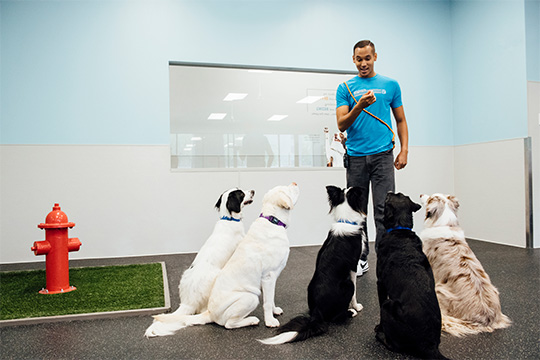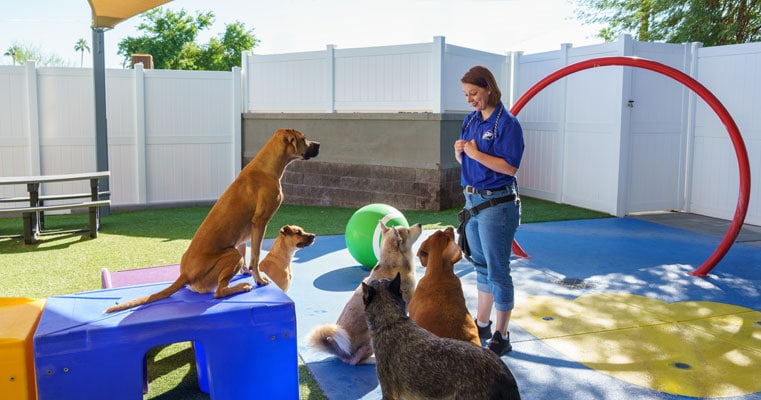Why Consistency is Key in Dog Training for Long-Term Success
Why Consistency is Key in Dog Training for Long-Term Success
Blog Article
Newbie's Overview to Effective Pet Dog Training in the house
Successfully educating a canine at home calls for a nuanced understanding of canine actions and reliable communication approaches. Establishing clear training goals, making use of premium incentives, and maintaining consistency throughout household participants are critical components. Incorporating training right into everyday regimens can improve both engagement and retention.
Understanding Pet Dog Actions
Comprehending pet dog actions is important for effective training and cultivating a harmonious partnership between human beings and their canine companions. Canines communicate primarily with body movement, vocalizations, and faces, making it crucial for owners to analyze these signals accurately. Recognizing behaviors such as tail wagging, growling, or shrinking can give insights into a pet dog's emotion and intentions.

Common behavioral issues, such as aggression, stress and anxiety, or too much barking, typically originate from misconceptions or unmet requirements. Observing and addressing these concerns without delay can protect against escalation and make sure a positive training experience. By cultivating a deep understanding of pet dog actions, proprietors can customize their training methods to fit their canine friends, eventually resulting in a satisfied and mannerly animal.
Necessary Educating Tools
A fully equipped training room can dramatically enhance the performance of pet training in your home. Vital training tools guarantee that both the pet and the trainer can take part in efficient sessions that cultivate learning and bonding.

Purchasing a strong chain and a comfy, well-fitting collar or harness is important for safety and control. These devices assist establish limits and make certain the pet dog stays safe and secure during training. Furthermore, a designated training location, free from interruptions, aids focus for both the pet dog and the trainer.
Educating aids such as training pads, cones, or dexterity equipment can additionally boost the experience by presenting range and difficulties. Having a notebook or electronic app for tracking development can be indispensable, permitting you to note successes and areas for enhancement. Making use of these essential tools will develop a positive training atmosphere and lay the foundation for effective learning.
Creating an Educating Regimen
Developing a consistent training routine is important for effective canine training at home. A well-structured regular not just aids in reinforcing wanted behaviors yet also supplies your pet dog with a feeling of protection and predictability. To develop an effective training regular, start by determining particular training goals, such as standard commands, chain walking, or house-training.
Pick a marked time daily for training sessions, preferably when your dog is sharp and receptive. Sessions should be short, around 5 to 15 mins, to preserve emphasis and prevent exhaustion. Uniformity in timing and atmosphere will certainly enhance your pet dog's knowing experience.
Include training right into everyday tasks to enhance abilities. For instance, method commands throughout walks or nourishment, which integrates finding out right into all-natural regimens. Furthermore, continue to be adaptable and readjust the routine as essential, suiting your canine's power degrees and mood.
Favorable Reinforcement Strategies
Positive support methods are basic like it to efficient pet dog training, promoting desired habits via benefits as opposed to penalty. This technique utilizes favorable stimuli, such as treats, appreciation, or play, to encourage Full Report dogs to repeat particular activities. The keystone of this approach is timing; incentives ought to be given instantly complying with the wanted behavior to develop a clear organization.
When applying favorable support, it is vital to choose benefits that are encouraging for your pet. High-value deals with, such as small pieces of poultry or cheese, can be specifically reliable throughout training sessions. Furthermore, differing the rewards can maintain your pet's rate of interest and enthusiasm.
Beginning with simple commands, like "rest" or "remain," and progressively progression to extra intricate tasks. Consistency is essential; ensure that all member of the family make use of the exact same commands and reward systems to prevent confusion.
In addition, it is essential to continue to be client and prevent stress. Dogs, like human beings, find out at their very own pace. By fostering a helpful training atmosphere through favorable support, you can improve your dog's knowing experience while strengthening the bond between you and your furry companion, laying the groundwork for effective training outcomes.
Typical Training Obstacles
While educating a pet dog in your home can be a satisfying experience, it often comes with a collection of typical obstacles that can test both persistence and uniformity. One common issue is interruption. Pets may come to be conveniently averted by noises, motions, or also scents in their setting, making it difficult to keep their emphasis during training sessions.
One more difficulty is incongruity in commands and reinforcement. It can puzzle the dog and impede progression if household participants use various signs or incentives. Establishing a unified strategy is vital for effective interaction.
Additionally, pet dogs can experience aggravation or stress, particularly if they do not comprehend what is expected of them. This can lead to unfavorable behaviors, such as barking or chewing.
Ultimately, the timing of support is crucial (Dog training). Delayed rewards can lessen the effectiveness of favorable reinforcement, as canines might stop working to link the habits with the reward
Overcoming these obstacles calls for dedication, clear interaction, and an organized training plan. Identifying and dealing with these typical challenges will certainly lead the way for a much more effective and pleasurable training experience in your home.
Final Thought
In final thought, successful pet training at home demands a comprehensive understanding of canine habits and effective interaction approaches. By establishing clear training goals and utilizing top quality deals with along with favorable support, the training procedure ends up being much more gratifying for anchor both the dog and the fitness instructor.
Establishing a consistent training regimen is necessary for efficient canine training at home.Positive reinforcement techniques are essential to effective dog training, advertising desired habits through incentives rather than penalty (Dog training). By cultivating an encouraging training environment with positive reinforcement, you can boost your pet dog's understanding experience while reinforcing the bond in between you and your hairy companion, laying the groundwork for effective training outcomes
In final thought, successful canine training at home necessitates a detailed understanding of canine habits and reliable communication approaches. By establishing clear training objectives and utilizing top quality deals with along with favorable reinforcement, the training process becomes much more rewarding for both the fitness instructor and the pet dog.
Report this page